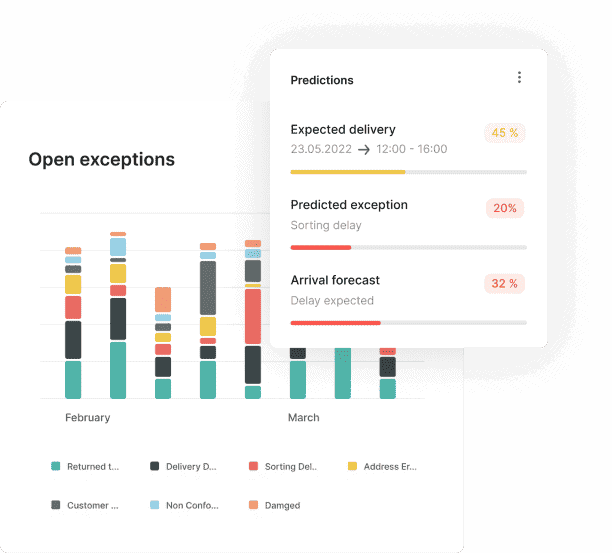Carrier parcel tracking is a crucial component of e-commerce and e-fulfilment operations. It improves customer satisfaction, reduces operational costs, enhances efficiency, and provides businesses with valuable insights for continuous improvement in their logistics and supply chain processes.
But how can you get more insights into often vague carrier statuses?
Let’s have a look at different ways to retrieve shipment data from carriers. Because this can be hassle-free!
What do we mean with carrier parcel tracking exactly?
Carrier parcel tracking refers to the ability to monitor and trace the movement of packages or parcels as they are transported through the shipping and delivery process by a designated carrier or shipping service. This tracking system provides real-time information about the status and location of a package, allowing both businesses and customers to stay informed about the progress of their shipments.
Typically, carriers assign a unique tracking number to each parcel, and this number serves as a reference to retrieve detailed information about the package’s journey.
How to retrieve tracking data from carriers?
Retrieving tracking data from carriers involves various processes and systems, each with its own technical complexities.
One of the most important steps is to set up a connection with the carrier’s tracking system. This can be done through various means such as API calls, web scraping, direct integration, or outsourcing to a third-party service.
Let’s take a closer look at each method.
1. Carrier API calls
API calls use Application Programming Interfaces (APIs) to enable different software systems to communicate. Carriers use APIs to share real-time shipment data.This process involves sending a request to the carrier’s server and receiving a response with the tracking information.API calls are the most common way to connect to a carrier’s tracking system.
Benefits of using APIs
- Real-time data: Access to up-to-the-minute tracking information.
- Automation: Streamline the data retrieval process, reducing manual efforts.
- Scalability: Easily handle large volumes of tracking requests.
Challenges with APIs
- Complexity: Requires technical knowledge for implementation.
- Rate limits: Some carriers impose limits on API calls, affecting large-scale operations.
- Security: Ensuring secure API connections to prevent data breaches.
2. Web scraping
Web scraping extracts data from carrier websites using scripts or software. This method requires understanding web scraping techniques and the structure of the carrier’s website. While effective, it can be complex and may need regular updates to adapt to changes in the website’s structure. Plus, it’s crucial to comply with the website’s terms of service to avoid legal issues.
Benefits of web scraping
- Customizable: Tailor data extraction to specific needs, such as gathering additional data not provided by APIs.
- No API required: Useful when carriers do not provide APIs, or when the available APIs are insufficient.
Challenges with web scraping
- Legal concerns: Ensure compliance with carrier terms of service to avoid legal issues.
- Maintenance: Regular updates needed to adapt to website changes, which can be time-consuming
- Reliability: Changes in website structure can cause data extraction failures.
3. Direct integration
Direct integration connects your system directly with the carrier’s tracking system. This method is the most comprehensive and reliable, providing real-time data access. However, it’s also the most complex and expensive option, requiring a deep understanding of the carrier’s system and potentially additional hardware and software. Ongoing maintenance and support add to the cost but ensure accurate, real-time data.
Benefits of direct integration
- Seamless data flow: Continuous data updates without manual intervention.
- High reliability: Direct connections often provide the most accurate and reliable data.
- Customization: Tailor the integration to meet specific business needs and workflows.
Challenges with direct integration
- Initial setup: Can be time-consuming, technically demanding, and expensive.
- Carrier cooperation: Requires extensive collaboration with carriers, which may not always be feasible.
- Maintenance: Ongoing support and updates are necessary to ensure continued functionality.
4. Outsourcing to a third party
Third-party outsourcing involves hiring an external service to manage parcel tracking data retrieval. This approach leverages the expertise and resources of specialized shipment tracking providers to ensure data accuracy and timeliness. Outsourcing can save time and money while ensuring reliable tracking information.
Additionally, outsourcing supports scalability. Collecting and processing tracking data internally can be time-consuming and challenging to scale. A third party can efficiently manage increasing data demands, providing consistent insights and analysis. This allows your company to focus on core operations.
Benefits of outsourcing
- Expertise: Leverage specialized knowledge, technology, and infrastructure.
- Cost-effective: Can be more cost-effective than developing and maintaining an in-house solution.
- Scalability: Easily manage increasing data demands without overburdening internal resources.
Challenges with outsourcing
- Cost: While potentially cost-effective, it can still be more expensive than other methods depending on the provider and service level.
- Dependency: Reliance on external providers for critical data can pose risks if service interruptions occur.
- Data security: Ensure that the third-party provider follows stringent data security protocols to protect sensitive information.

How can you ensure the accuracy and timeliness of carrier parcel tracking data?
Ensuring the accuracy and timeliness of carrier parcel tracking data is key for customer satisfaction, but is no easy task. It involves constant monitoring and updating of tracking systems, which can be both time-consuming and labor-intensive.
High fees from carriers for access to their tracking systems can quickly add up, especially when using multiple carriers. In addition, there may be additional costs for maintaining and updating these systems.
These challenges can make it tough to get reliable and up-to-date tracking data. Outsourcing this task to a trusted and experienced partner can be a smart, cost-effective way to handle the complexities of tracking data management.
Curious how we can make parcel tracking easier for you? Let’s chat about how Sendcloud can simplify your parcel tracking with seamless integration and real-time updates. Reach out to learn more!








